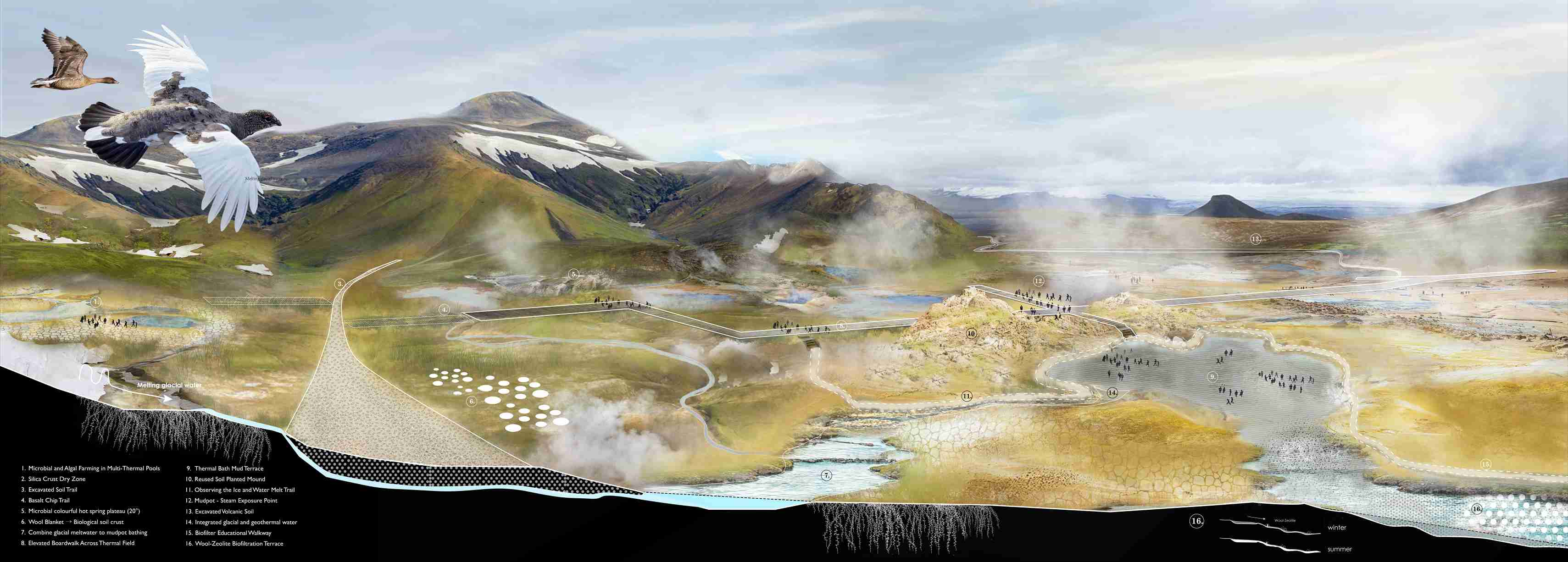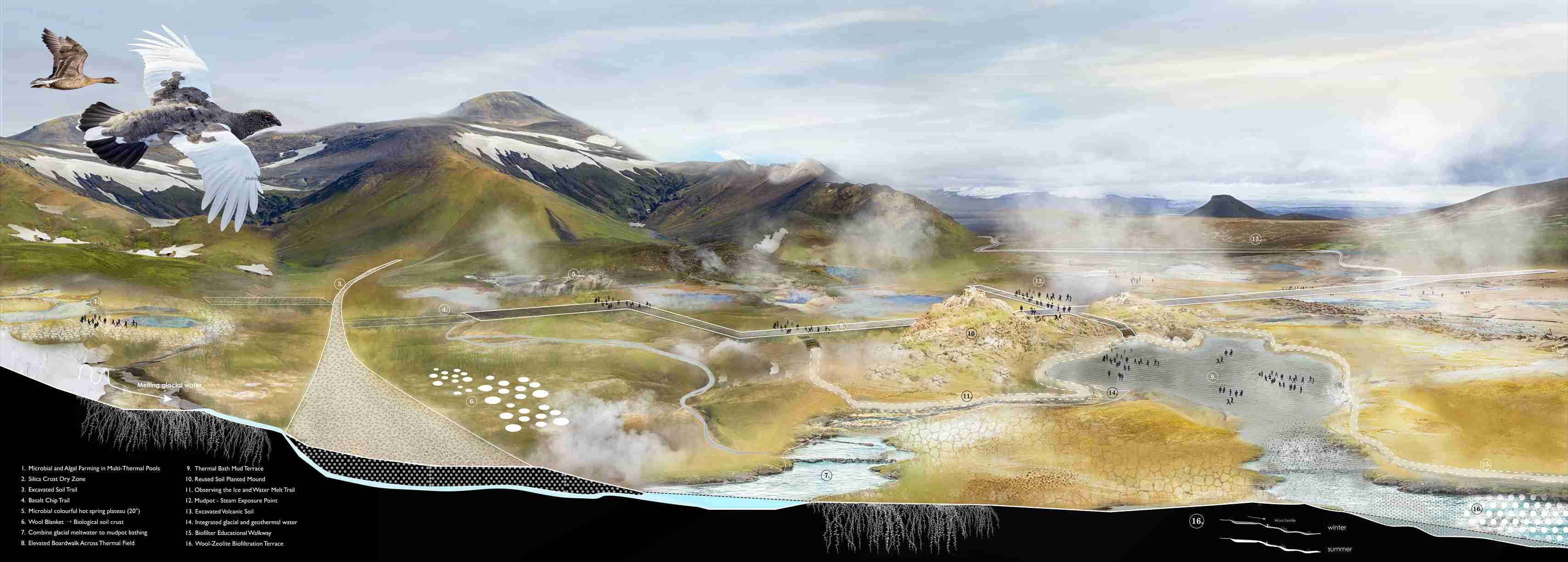

From Heat To Life: Rejunavting Vonarskarð Future Geothermal Landscape
In the volatile intersection of heat, water, and microbial life, new landscapes begin to form—quietly, incrementally, beneath the surface. Vonarskarð, a geothermal valley suspended between glaciers and volcanoes in Iceland’s highlands, is one such terrain: visually barren, yet metabolically active. This project aims to rejuvenate this fragile geothermal landscape not by restoring what was lost, but by uncovering and utilizing the interactions between geothermal hot spring systems and microbial life as a design catalyst.
Grounded in the theory of landscape metabolism, the project reconceives the site not as a static composition, but as a dynamic, living system—where energy, water, minerals, and organisms circulate, decompose, and regenerate over time. Across four nested spatial scales—from national territory to geothermal catchment to detailed material prototypes—it introduces minimal, site-specific interventions: wool blankets, microbial farming systems, and filtered bathing zones. These foster the emergence of mosslands, biofilms, and sensory environments.
The outcome is twofold: a Geothermal Archive Park (masterplan) and a Thermal Succession Garden (detail scale), both centered around bodily and temporal engagement with geothermal features. Rather than framing geothermal activity through extraction or spectacle, the project embraces entropy and ecological succession—positioning Vonarskarð as a speculative archive of ongoing metabolic processes. Here, heat and life co-evolve, offering not only a new form of rejuvenation, but also a long-term vision for regenerative, experience-driven geothermal landscapes.

The term “landscape metabolism” draws from ecological and urban metabolic theories, where landscapes are understood as dynamic systems of energy exchange, material transformation, and biotic flows. Just like organisms,
landscapes digest and regenerate through cycles of erosion, accumulation, and renewal.
In this project, landscape metabolism frames Vonarskarð not as a static site, but as an evolving energy terrain where geothermal heat, glacial melt, microbial growth, and human sensing interact to generate ecological succession and material expression.
Enrtopy: Originating from thermodynamics, entropy refers to the degree of disorder in a system and its tendency to move toward equilibrium. In ecological and landscape contexts, entropy reflects the natural shift from structure to chaos and the potential emergence of new order through energy dispersal.
Here, entropy is used to interpret geothermal and microbial transformations at multiple scales—where geothermal springs release energy and disorder, but also cultivate new life, deposits, and sensorial experiences. Entropy becomes a lens through which the site’s regenerative potential is understood.
Vonarskarð is a remote geothermal valley located in the central highlands of Iceland, between the
Vatnajökull glacier and the Bárðarbunga volcanic system. The site lies within one of the most geologically active
zones on the island, shaped by the convergence of glacial meltwater and geothermal heat. Characterized by mudpots, fumaroles, silica terraces, and scattered warm springs, the landscape is visually striking but ecologically fragile. Vegetation is sparse—mostly mosses, grasses, and pioneer species—yet microbial life thrives beneath the surface, forming colourful biofilms in thermally active areas. The terrain is constantly evolving, marked by fluctuating temperatures, mineral sedimentation, and seasonal hydrological shifts.Vonarskarð remains largely inaccessible and uninhabited, offering a rare opportunity to observe raw geothermal processes and explore how energy, matter, and time interact in a landscape on the edge of transformation.

This animation explores the dynamic geothermal system of Vonarskarð, focusing on two key geothermal features: mudpots and hot springs. Through the visual sequence, the animation investigates how these geothermal phenomena evolve across scales, from the body scale, where the physical landscape and geothermal activity are directly experienced, to the micro scale, where microbial communities become crucial actors in the landscape’s transformation. The animation reveals the complex interplay of variables—such as heat flow, mineral deposition, water movement, and microbial colonization—that drive the metabolic processes of the site. By emphasizing how microorganisms respond to and influence geothermal dynamics, the animation highlights the hidden but vital ecological processes that shape the landscape over time.













This experiment explored the potential of microorganisms as natural dyes through a 14-day cultivation process. The test was conducted in a laboratory setting to investigate how microorganisms grow and produce pigments that can be transferred to textiles.
Over a two-week period, the selected microorganisms were cultured in petri dishes under controlled conditions.
Once mature, their pigmented colonies were gently pressed onto fabric samples to transfer the natural color. A fixative (mordant) was then applied to ensure the retention of the color on the textile surface,
thus completing the dyeing process.
This prototype is an early investigation into the application of microbial coloration in landscape-based material strategies. It provides a reference for strategy 1, where biomass production in geothermal pools
may have both ecological value and resource potential - enabling localized, sustainable dye extraction embedded in on-site processes.
Microscopic observations revealed the diverse pigmentation, structure, and morphology of the cultured microorganisms, highlighting their potential for dye extraction and demonstrating the color complexity that can be achieved through microbial textile experiments.
Inspired by the visual morphologies observed under the microscope, I conducted artistic experiments using wool felt as a medium to simulate the color and morphological diversity of geothermal microorganisms. The softness of wool and the dispersion of its fibers mimic microbial morphology—such as round colonies, branching filaments, or pigment clusters—allowing us to reinterpret the invisible microbial world through tactile and visible material expression.



Composite materials made of wool and zeolite are applied to water edges and exposed ground. These act as ecological filters to absorb heavy metals and offer a base for moss growth. This strategy was informed by my earlier material experiments and is key to bio-crust and moss co-evolution. I built a prototype testing moss colonization on wool, exploring wool as a medium for biofilm formation
In geothermal habitats, where life begins with only heat and minerals, this strategy focuses on creating conditions for life, not life itself. Through microtopography and the strategic deposition of organic-rich sediments' and wool blankets, barren land is transformed into moss, spores, and decaying soil.
The wool blanket is a designed medium that delivers microbial life, retains moisture, and decomposes into organic matter — forming the soft beginning of future soil.
At the detail scale, garden focuses on bodily engagement with geothermal processes through multisensory spatial experiences. It explores landscape metabolism at a 1:1 scale—where heat, moisture, and microbial life interact with human perception. Four key zones define this experience: a boardwalk through vibrant geothermal pools and mud springs; an ecological mossland trail; a series of multi-thermal microbial cultivation ponds and ditches; and a therapeutic bathing area with integrated wool-zeolite filtration. These spaces allow users to see, touch, smell, and hear geothermal activity experiencing Iceland's subterranean energy as both spectacle and process. All interventions use local materials and include sustainable wastewater treatment, ensuring minimal ecological impact downstream.





Thousands of years later, when geothermal activity is no longer active and thermophilic microorganisms are diminishing, the boardwalk will decay into early driftwood, the site will become a large wetland, and the entire park will become a green monument archive documenting this landscape metabolism in the uplands.